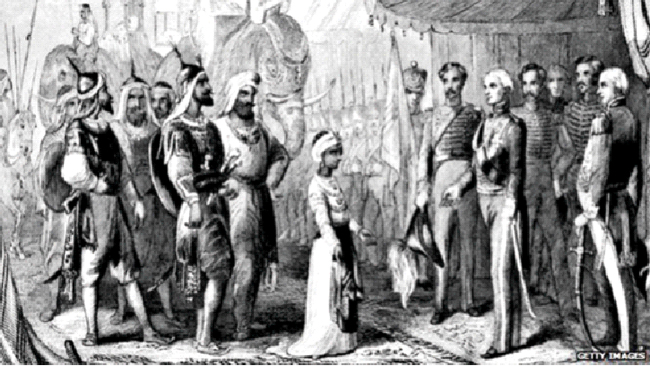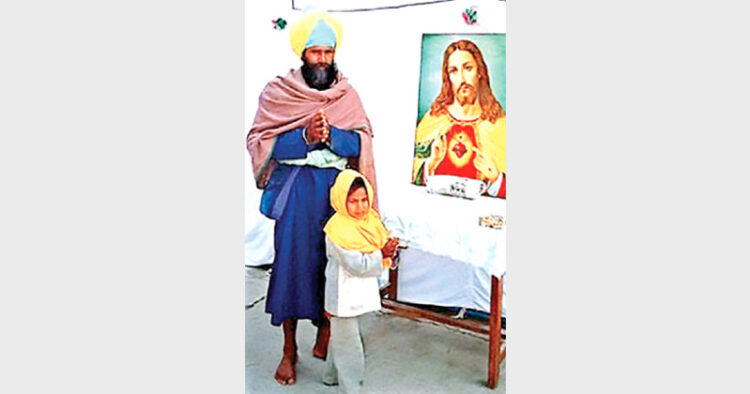When the East India Company took over political control of Punjab in 1849, Christianity started attacking the indigenous religious practices of the region with full force. The advent of Christian missionaries in Punjab started in the decade of the 1800s itself. In the North-West province, seven Protestant missionary societies from 1800 to 1857 were engaged in evangelical activities.
A book published by Dipankar Gupta titled on the question of caste in Sikh religion discusses how British imperialism in Punjab opened the gates for Christian missionaries in the province. The motive of these missionaries was converting the masses to Christianity in the first place. Thus after some time, the indigenous religious practices of Punjab started facing existential threat.
Taking Over Govt Offices
It was only after 1891 that Christianity gained firm ground in Punjab due to mass conversions. As recorded by John CB Webster in his book “Social history of Christianity in north-west India in 1800”, there were 3,912 Christians in Punjab in 1881. But as per the census report of the Punjab Government in 1855, there was not a single Indian Christian in the province. Christopher Harding in his book “Religious conversions in South Asia and the meaning of conversions in Punjab'' states that at the end of 20th century, there were more than 30 Christian missionary organisations, who were engaged in evangelical work, which included American United Prebestian and Baptist, Methodist, Scotland Church, Belgium Capuchin and Salvation Army. All these different Christian denominations were competing with each other for converting the local population. These denominations used to get official patronage of the British officers posted in Punjab. The major British imperial personnel in Punjab like Sir Henry Lawrence, Sir John Lawrence, Sir Robert Montgomery, Donald McLeod and Colonel Edwards believed that all the Government offices should be handed over to the Christian missionaries and teaching Bible should be made mandatory. The Church and missionaries had an agenda to spread Christianity in India from upper castes and then to lower castes.

Mission Accomplished
Similarly, Khushwant Singh in his book “History of Sikhism” had written that the biggest victory missionaries got was in 1853, when they were able to convert Maharaja Duleep Singh to Christianity. This was a great shock to the followers of Sikhism. Apart from Duleep Singh, majority of the Sikhs who got converted to Christianity came from untouchable castes.
As per Jerry Cox, by 1931, Christians constituted seven percent of the population in the districts of Gujranwala, Sialkot and Sheikhupura. Majority of the newly converted Christians came from one particular caste. As per the census report of 1891, there was a 410 percent increase in the number of people getting converted to Christianity compared to the earlier decade. Until 1931, the population of Christians went on increasing. The population increase of Christians was 325 percent in 1931.
Countering Missionaries’ Project
Christian missionaries came with new innovative ideas for their evangelical project in Punjab. The result of this was that to counter them, the followers of other religions too adopted the similar strategies of missionaries. The evangelical activities included hiring people as missionaries, distributing literature and on public roads doing preaching. The followers of other religions started rejecting Christian ideals for protecting their religion. In his book titled “Swami Dayanand Saraswati’s critique of Christianity”, Kenneth W Jones has stated that it was the conflict aimed at spreading their own true values and countering the false beliefs of the others.

Creating Artificial Divide
Devendra Swaroop through his work on casteless India has brought to light the hidden agenda behind the census activity of the British Raj. He notes that MA Sheering, who in 1872 had written “Hindu Castes and Tribes” while discussing caste as a negative force in Calcutta Review in 1880, said that the unity which is found in other nations doesn't work in India. Caste breaks that in India. This destructive colonial idea became the driving force behind the census project started in 1871. It was aimed at portraying the Hindu society in different castes, religious beliefs and dialects. To fulfil their imperial agenda, British colonists from 1871-72 itself started creating a list of various castes and creating artificial divide between them.
The biggest victory missionaries got was in 1853, when they were able to convert Maharaja Duleep Singh to Christianity. This was a great shock to the followers of Sikhism. Apart from Duleep Singh, majority of the Sikhs who got converted to Christianity came from untouchable castes
Bishop Deendayal’s book published by Hindi Theological Literature Committee, Jabalpur; titled “Uttar Bharat tatha Pakistan mein Masih Dharma” (Christianity in North India and Pakistan) states that witnessing the interest Mazhabi Sikhs (Dalit Sikhs) were taking in Christianity, a mission station was set up in Khairabad near Peshawar in 1860. Mazhabis were considered socially lower in Rohilkhand. The census reports of Punjab can be cited to witness the growth of Christianity in Punjab. The population increase of Christians recorded as per the census in Punjab in following decades was 3,796 in 1881; 19,547 1891; 37,980 in 1901; 1,63,994 in 1911; 3,15,931 in 1921 and 4,14,788 in 1931.
Swelling Numbers
Apart from this, the Christian population of Punjab which was 255116 in 1991 increased to 292800 in 2011. Besides that, the Hindu population of Punjab is also growing which has reached 38.49 percent in the State’s total population, growth of 18.6 percent. The point to be noted is that the population increase of Christians in Punjab is higher than the Sikhs. While the percentage increase of Sikhs in Punjab is 9.6 percent, Christian population in the state is increasing by 18.9 percent. As per the census of 2011, the total population of Christians in Punjab is 3,48,230. The bordering districts of Punjab – Amritsar, Gurdaspur and Ferozepur are witnessing increasing demographics of Christians rapidly.













Comments